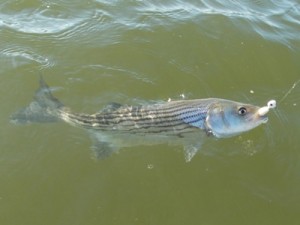
Two recent surveys of juvenile striped bass in waters of the Chesapeake Bay indicated mixed results for the bay wide stock.
Conducted by biologists in Maryland and Virginia the surveys included counts of juvenile striped bass and other species in waters of the Chesapeake Bay.
Maryland
The Maryland Department of Natural Resources (DNR) recently announced the results of its young-of-year (YOY) striped bass survey, which tracks reproduction of the species in Chesapeake Bay.
The 2019 juvenile striped bass index is 3.4, below the 66-year average of 11.6.
The young-of-year striped bass survey measures the annual spawning success of the state fish, commonly known as rockfish.
The index represents the average number of recently hatched striped bass captured in samples taken during the survey.
During the 2019 survey, biologists collected more than 51,000 fish of 54 different species, including 445 young-of-year striped bass.
The abundance of some important forage species like silversides, spot, and menhaden increased in Maryland waters. White perch and yellow perch experienced below-average reproduction, according to survey results.
Beginning in 2018, DNR launched initiatives aimed at reducing striped bass mortality during the fishing season.
Those measures included new regulations on size limits and mandatory circle hooks, plus an education campaign on safe catch-and-release practices that now includes an advisory system on optimal conditions for fishing.
Maryland DNR has monitored the reproductive success of striped bass and other fish species in Maryland’s portion of the Chesapeake Bay since 1954, making this one of the oldest fish surveys in the country.
Twenty-two survey sites are located in the four major spawning areas: Choptank, Nanticoke, and Potomac rivers and the Upper Chesapeake Bay.
Biologists visit each site three times per summer, collecting fish with two sweeps of a 100-foot seine net. After each observation, scientists return the fish to the water.
The index number is the result of averaging the number of recently hatched striped bass caught in each of these samples.
source: Maryland Department of Natural Resources
Virginia
Preliminary results from an ongoing long-term survey conducted by researchers at the Virginia Institute of Marine Science suggest an average year class of young-of-year striped bass was produced in Virginia tributaries of the Chesapeake Bay in 2019.
The 2019 year class represents the group of fish hatched this spring that will grow to fishable sizes in three to four years.
The program, formally known as the Juvenile Striped Bass Seine Survey, recorded a mean value of 9.54 fish per seine haul in the Virginia portion of the Chesapeake Bay, which is similar to the historic average of 7.77 fish per seine haul.
The 2019 value, which scientists call a recruitment index, was also similar to indices observed in the past six years.
Although there can be considerable variation in striped bass recruitment among years, the average indices observed in recent years suggests that abundance of juvenile striped bass has been stable.
Striped bass play an important role as a top predator in the Chesapeake Bay ecosystem and are a valuable resource for commercial and recreational anglers.
The VIMS Juvenile Striped Bass Seine Survey currently samples 18 index stations in the Rappahannock, York, and James River watersheds.
Biologists sampled each site 5 times from mid-June to late August in 2019, deploying a 30.5 m-long (100-foot) seine net from the shore. Each fish captured in the net is counted, measured, and returned to the water. These young striped bass usually measure between 40 and 100 mm (1.5-4 inches) long.
Survey scientists in Virginia measured 1,624 juvenile striped bass at these stations in 2019. VIMS has been conducting the survey annually since 1967 for the Virginia Marine Resources Commission (VMRC).
The striped bass population in Chesapeake Bay has rebounded from historic lows in the late 1970s and early 1980s, after fishing bans were enacted in Delaware, Maryland, and Virginia in the mid- to late-1980s.
Since then, the population increased to the point that striped bass in the Bay and elsewhere were considered recovered.
In 2019, scientists determined that the striped bass population was overfished and that mortality due to fishing was higher than what the population can withstand in the long term.
Monitoring of juvenile striped bass recruitment will continue next year to provide managers with crucial information to sustainably manage this important species.
source: Virginia Institute of Marine Science
Related Information
Leave a Reply
You must be logged in to post a comment.